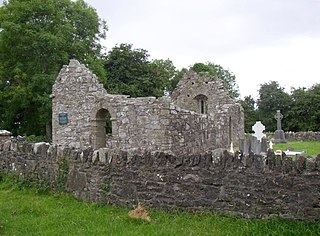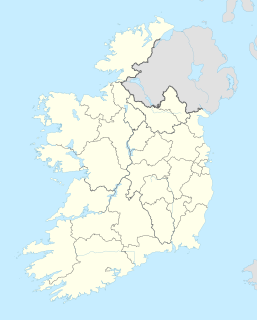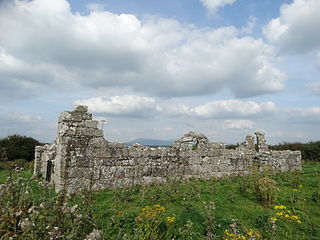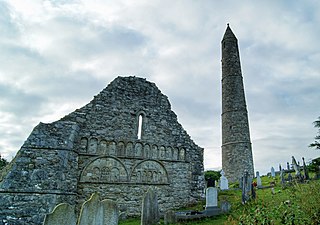
A clochán , or beehive hut, is a dry-stone hut with a corbelled roof, commonly associated with the south-western Irish seaboard. The precise construction date of most of these structures is unknown with the buildings belonging to a long-established Celtic tradition, though there is at present no direct evidence to date the surviving examples before c.AD 700". Some associated with religious sites may be pre-Romanesque, some consider that the most fully intact structures date after the 12th century or later. It is where monks lived.

Aghadoe Cathedral was a church that may have been the seat of a bishop at Aghadoe, Ireland. The now ruined cathedral overlooks the Lakes of Killarney from Aghadoe, a few miles from Killarney. Aghadoe may have been the site of a church as early as the seventh century, but extant remains are of a stone structure built in the eleventh and twelfth centuries.

Ullard Church is a medieval church and National Monument in County Kilkenny, Ireland.

Sheepstown Church is a medieval church and National Monument in County Kilkenny, Ireland.

Ballintaggart Ogham Stones is a collection of ogham stones forming a National Monument located in County Kerry, Ireland.

Kileenemer Church is a medieval church and a National Monument in County Cork, Ireland.

Ratass Church is a medieval church with ogham stone forming a National Monument in Tralee, Ireland.

Dunloe Ogham Stones is a collection of ogham stones forming a National Monument located in County Kerry, Ireland.

Killelton Church is a medieval church and a National Monument in County Kerry, Ireland.

St. Manchan's Oratory, also called An Teampall Geal is a medieval oratory and National Monument in County Kerry, Ireland.

Inchagoill is an island in Lough Corrib, Ireland. Its Christian ruins constitute an Irish National Monument. The island name means "Island of the devout foreigner."

Mungret Abbey is a medieval friary and National Monument located in County Limerick, Ireland.

Glanfahan is a townland on the Dingle Peninsula, Ireland, notable for its large collection of clocháns, which form a National Monument.

Church Island is a medieval Christian monastery and National Monument located in Lough Currane, Ireland.

Maumanorig or Kilcolman is the site of the remains of a medieval Christian monastery and National Monument located on the Dingle Peninsula, County Kerry, Ireland.

Kilbennen or Kilbannon is a medieval ecclesiastical site and National Monument located in County Galway, Ireland.

Ballywiheen is a medieval Christian site and National Monument located on the Dingle Peninsula, Ireland.

Reenconnell is a medieval Christian site and National Monument located on the Dingle Peninsula, County Kerry, Republic of Ireland.

The Emlagh East Ogham Stone, also called the Priest's Stone is an ogham stone and a National Monument located in County Kerry, Ireland.

St. Declan's Monastery, containing the remains of Ardmore Cathedral, is a former monastery and National Monument located in County Waterford, Ireland.





























